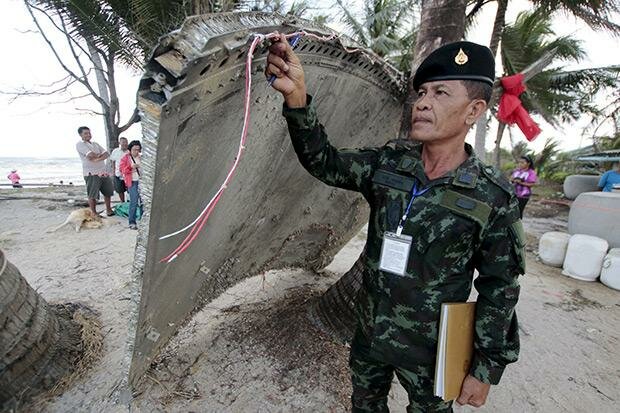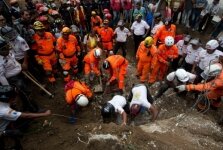A soldier inspects a piece of a possible rocket part that was found off the coast of southern Thailand in Nakhon Si Thammarat province Jan 24. A piece suspected of being plane wreckage from Malaysia Airlines Flight MH370 likely is part of a Japanese rocket, a Japanese manufacturer says. (Reuters photo)
TOKYO — A Japanese rocket maker says a large piece of metal that washed up on a beach in Thailand is likely part of a rocket launched by Japan, not a missing Malaysian plane.
The discovery of the metal sparked speculation that it might be from Malaysia Airlines Flight 370, which disappeared almost two years ago.
Mitsubishi Heavy Industries said Monday that the metal piece is highly likely to be part of a Japanese H-IIA or H-IIB rocket that was launched from southern Japan, based on an initial examination of photos and videos of the object.
Company spokeswoman Sayo Suwashita said officials are trying to determine which rocket and its launch date. Rocket debris falls into the ocean after every launch, and most is collected but sometimes pieces can be found some distance from the launch site, including in foreign waters, she said.
Japan has launched H-IIA and H-IIB rockets since the 2000s. The most recent H-IIA launch was in November.
Flight 370 took off from Malaysia in March 2014. It lost communications and made a sharp turn away from its Beijing destination before disappearing. It is presumed to have crashed in the southern Indian Ocean, far away from Thailand.
The debris was found on the eastern coast of Nakkon Si Thammarat.
Malaysian Transport Minister Liow Tiong Lai said Sunday that the search for the missing jet, which carried 239 people, is ongoing in the Indian Ocean and that its second phase is expected to be completed by June. Australia has led a multinational search that has so far cost more than US$120 million.
The Australian Transport Safety Bureau announced Monday that the search of 120 square kilometres of seabed where the Boeing 777 is thought to have crashed had been set back after a ship lost its sonar equipment.
The Fugro Discovery, one of three ships conducting the search, towed its side-scan sonar unit on Sunday into a mud volcano that rose 2,200 meters from the sea floor, the bureau said in a statement.
The ship lost the sonar unit plus 4.5 kilometres of cable. The ship is now making a six-day journey to the Australian port of Fremantle to collect new cable and will continue the search with spare sonar equipment, it said.






